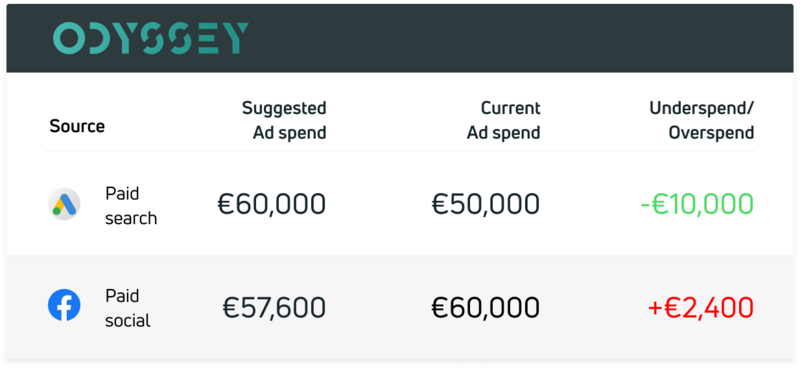How Odyssey uses Google Analytics as a tracking source
One of the biggest benefits of Odyssey Attribution is that we are able to extract the raw data from Google Analytics. How, you are asking? Let us explain
Adoption of marketing attribution is getting more and more important for many CMOs and other decision makers. In this blog post, we’ll inform you with 5 things you should know when starting with marketing attribution.
When most marketers learn the reasons behind the need for an attribution model necessary, they get it. There’s an ah-ha moment. Of course you can’t give a single promotion method full credit for most conversions. Of course it is exceedingly rare that a consumer’s path to purchase is ever as simple as that.
That would be great, except that understanding isn’t the main barrier to adoption when it comes to marketing attribution.
Many CMOs and other decision makers–whether they do it consciously or not–delay or forgo converting to a sophisticated model of tracking e-commerce conversions for a whole other reason.
Marketing attribution just seems too hard. The thing is, it doesn’t have to be. That is, as long as our first piece of advice is followed: start now.
We’re not saying you shouldn’t do a deep dive into all there is to know about multi-touch marketing attribution. You should. There are some highly sophisticated models out there, which may offer you exceedingly detailed insights. In particular, as a buyer, there’s research you may want to read about custom marketing attribution modelling. We, of course, think that our attribution platform is ultimately the one you’ll want to use. However, we also think that every marketer should keep reading and learning continuously–about every method and tool that’s available.
What we mean by “start now,” though, is that it’s okay to begin where you are and refine as you go. Start with the simple steps that will kick off your company’s journey into the world of multi-touch. You don’t have to stop there. But, don’t use the amount that there is to learn as an excuse not to get started. As with many complex projects, it’s easy to accidentally put off adoption of a better model of attribution in perpetuity while you continue to think through how you’ll implement it. Sure, you’ll be in good company as you drag your feet; eConsultancy reports that less than a third of organisations are currently evaluating their marketing plans using a defined attribution model. But, is that the company you’re really looking to keep?
A recent iProspect report estimated that the typical gain in media efficiency that companies experience when implementing an attribution model is 15 to 35 percent. With that type of improvement on the table, you need to get started.

When starting with marketing attribution, don’t fully rely on data. You should pay for tools that do what machines do best: slice and dice data in the smartest way possible and deliver the resulting insights in the most digestible format available.
But you should leave the human part to, well, humans.
What does that mean, exactly? It means that common sense still needs to be a part of your marketing attribution plan. A multi-touch marketing attribution tool will tell you the things that can be known based on your online marketing actions. But you will need to fill in the parts about which you know best.
Data acquired and shown by an attribution tool, have to be converted into concrete actions. With the current state of technology, people are much better at this than computers. You should always use your common sense.
Please don’t decide that, now that you’ve got it, data is the only basis for any choice you’ll make. That may lead to pivoting every time numbers start going in a different direction. Change is good. Constant unnecessary change is a business’s death knell. You’ll need your human brain to remind you that consistency in your marketing efforts will pay off, even if the data isn’t showing you that yet.
Read our blog post on the Do’s and Don’ts of Marketing Attribution.
And, that brings us to another thing that data doesn’t get the last word on: your unique company. Every business has its specific properties. And great marketers are highly attuned to those differences. For instance, one type of sale may be more valuable to your business than another–even though the reason for that value differential would be impossible for any technology to pick up on. Factoring that in will be essential.
In addition, understanding changes in the offline world that may be impacting sales is also key. The other night, The Oscars were hosted and a Kardashian carried the purse that a company manufactures. Epic snow is expected and only one online business has snowblowers in-stock and offers free delivery. These instigating events won’t show up in those businesses’ online data, but the results of them will. So, a multi-touch attribution model needs to be overlayed with the additional information that a marketing team knows about the non-adressable channels.

Once a team decides to get started with an attribution model, it can be hard to know where to stop. There is such power in understanding the relative impact of different marketing activities. And it’s only natural to want to continue to refine that understanding so that decision makers have the absolute best information with which to allocate their marketing dollars.
That’s fine. Until it isn’t.
No multi-touch attribution model is ever going to be perfect. If a quality system has been chosen, and common sense is still being applied, then incredible insights can be gained. But those same insights lose their value if they’re ignored in favour of continuing to nudge the needle toward perfection.
We recommend striking a balance between knowing all there is to know about how a sale was made, and getting to work using the insights that you now have.
Read our blog post on the problem with ROAS
Of course, if your version of “good enough” includes using the out-of-the-box tools from Google and Facebook, you’re not there yet.
We believe firmly that marketers should use an attribution tool that’s independent, transparent and actionable. So, not those provided by Google or Facebook. Or any other traffic provider, for that matter.
There are a host of potential problems that come from asking one of the sources for your traffic to tell you how important that traffic is. And all of those problems are amplified big time when those traffic sources are also making money off of your advertising spend.
Does it really make sense to ask the people who are trying to sell you advertising to tell you whether or not that advertising is the best way to spend your money? Of course it doesn’t. What makes good sense is to use data that you can trust.
Most of an online retailer’s traffic will likely come from Google and Facebook. So much of the marketing staff’s time may be spent looking at those two sources and figuring out how to optimise the delivery of traffic from both spots. A multi-touch attribution tool that is independent of those two powerhouses will offer the best information for how to do that.
How Odyssey uses Google Analytics as a tracking source
One of the biggest benefits of Odyssey Attribution is that we are able to extract the raw data from Google Analytics. How, you are asking? Let us explain
What if we could re-start affiliate marketing?
The lack of a proper attribution model within the industry is actually more or less how we got to the first version of Odyssey. However, there are more topics in which I believe the affiliate industry is completely missing the point.
How to include costs and revenue in your attribution model?
It's important to see which marketing channels drive most of the value, but if these channels cost you a fortune, you don't want to spend all your marketing budget there. Therefore, including both costs and revenue in your MTA model is essential.


